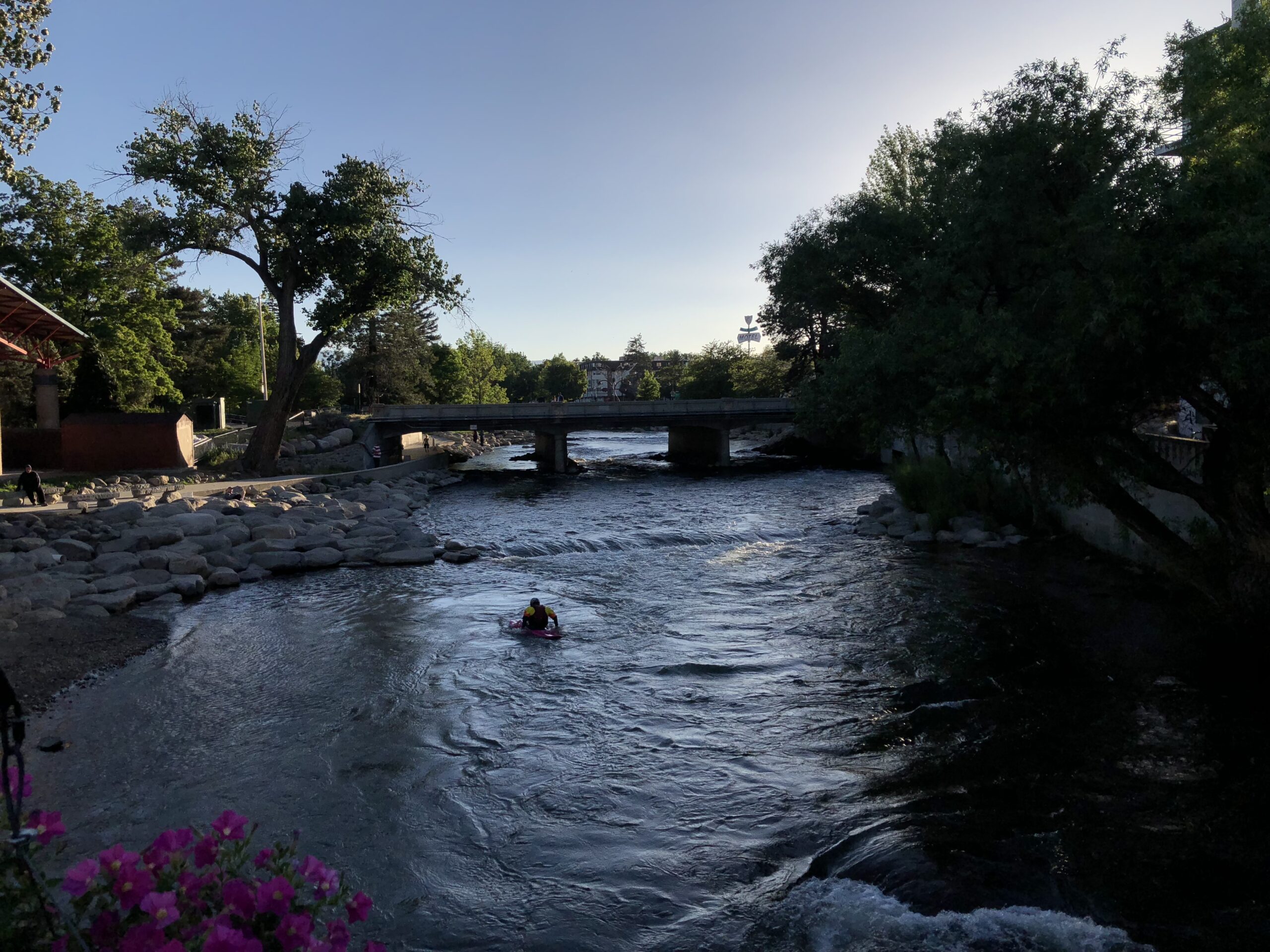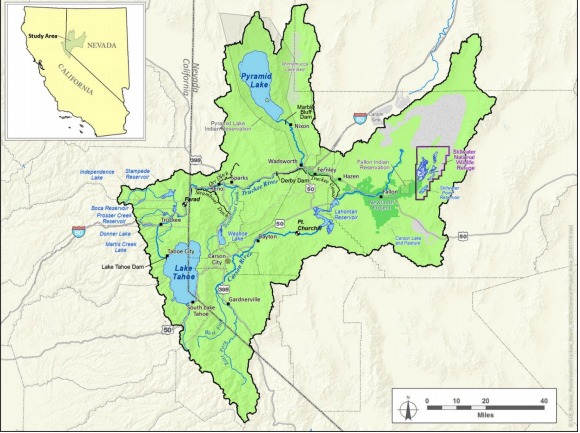Study: Truckee River Basin may need more water storage because of rising temperatures

The situation on the Truckee River is similar to the one facing many water managers across the West. In recent years, warming temperatures and changes to precipitation have started to affect the way snowpack falls, when it melts and how it runs off into a river system like the Truckee, the lifeblood for farmers and cities in an area that is arid and is expected to become more so.
What climate change means for the Truckee River is a subject of continuing research, but it’s something that federal water managers have been trying to model for years. And it came back into the news in August when the Bureau of Reclamation, which built and controls many of the dams across the West, presented an update of its Truckee Basin Study to the board of the Truckee Meadows Water Authority (TMWA), the municipal water provider for the Reno area.
“Change in supplies is likely to happen because we are getting less snow and earlier runoff,” Arlan Nickel, basin study manager for the bureau’s Mid-Pacific region told the TMWA board. “Also we’re seeing changes in demand...with an earlier growing season… [And there are] potential changes in the ecosystem if we are managing endangered species in the Truckee River.”
None of this is new.

The study of the Truckee River, about 3,060 square miles of river starting at the northeast end of Lake Tahoe, was completed in 2015. Although much of the information in the study was old news, there was one number in the bureau’s August presentation that stuck out to board members.
In its presentation, the Bureau said that to adapt to the driest climates by the end of the century, there could be a need for as much as 800,000 acre-feet of new storage, an amount the bureau said was “equivalent to four Stampede Reservoirs.” One acre-foot is equivalent to the amount of water that can fill one acre of land (slightly more than a football field) with one foot of water.
On a river system, stored water, often kept in a reservoir, can be used to supplement natural river flows for cities and agriculture during years of drought or higher demand for water.
Simply put, 800,000 acre-feet is an enormous amount of water for the relatively small Truckee River, yet the comparison to Stampede, a reservoir impounded outside of Truckee, California, had some asking about creating new large-scale reservoirs along the Truckee River with dams.
Building a new Stampede-scale reservoir would be a massive and controversial undertaking. Available land is a huge barrier; there are few unimpeded sites left for a dam to impound a reservoir that stored water for cities and farms. It would also be costly and likely have large environmental impacts.
Will four new Stampede Reservoirs be built? For now, the answer appears to be dam no!
Even the Bureau of Reclamation, criticized by some Westerners for its reliance on existing dams and its openness to new ones, brushed aside the idea of new large-scale Truckee projects.
“That’s probably not a very good alternative under future conditions,” Nickel said in an interview.
The Truckee reservoir system is already inefficient due to evaporation, he said. Of the roughly 600,000 acre-feet available for storage in Lake Tahoe each year, 400,000 acre-feet evaporates.
The fact is staggering and when Nickel repeated it to the board, the board’s chair spoke up.
“I want to be clear,” Vaughn Hartung, also a Washoe county commissioner, began, asking in apparent disbelief for Nickel to clarify the statistic. When he did, Hartung responded: “Wow.”
Nickel said water users should look at storage that is insulated from the effects of evaporation.
New dams might be out, but that doesn’t mean water users won’t develop more storage. The bureau’s climate numbers through the end of the century, under the driest conditions, call for a lot of it. As Reclamation noted in its board update, presented on Aug. 15, there could be a need for storing up to 800,000 acre-feet, or about 10 times what TMWA’s customers use in a year.
It’s important to note that the 800,000-acre feet forecast is for all users of the Truckee, not just TMWA. The water the bureau had identified in its basin study would be stored for municipal and agricultural users. But the conclusion remains the same: The bureau believes there is a need for more storage, from changing the way the dams operate to pumping water into the ground for future use.
In a series of sobering forecasts, Reclamation suggested that the storage would be necessary because of the way that human-caused climate change is affecting snowpack and streamflow. As temperatures continue to rise, scientists predict there could be less snow. Yet in many ways, it’s changes to how the snow falls and melts that will pose the most significant challenges.
Water managers tend to view snow as a natural storage bank. Water accumulates throughout the winter and is “stored” on the mountain top and then melts into rivers for the irrigation season in the spring. Under climate change, that dynamic is predicted to shift, as more precipitation falls as rain — where once it would have fallen as snow — and runoff occurs earlier in the season.
If more snow melts in January, less water can be stored in the Truckee’s reservoirs for when it’s needed later in the year. Reservoirs must release water when they reach certain elevations to prevent flooding. That’s one reason that Reclamation is calling for more storage on the river.
Another reason is how climate change might affect the end user. Changes in demand could place more strain on the river system, Reclamation suggested. Cities are expected to grow and need more water. With earlier runoff, there could be a longer growing season. A drier climate might also require more releases of stored water to bolster populations of endangered species.
One idea for creating new storage, Nickel said, is to update dams or change the requirements for when water is released from reservoirs to prevent flooding. The Army Corps of Engineers already uses formulas to determine the releases, and Nickel argued they could be updated.
“The Army Corps has been doing some of that but it’s very difficult to do,” Nickel told TMWA, noting that the public engineering branch errs on the side of the safest, conservative estimates.
There’s another possible storage project: putting water into aquifers.
Throughout the Southwest — in Southern Nevada and across the Colorado River Basin — this type of storage has been a popular choice for water users. The idea would be to capture excess water and store it as groundwater. In droughts, water users could build wells to pump it for use.
TMWA has done some small-scale groundwater storage projects but is exploring the option on a larger scale. As far as TMWA is concerned, officials with the municipal water provider argue that they are in good shape to meet the demands that would come with a prolonged drought.
John Enloe, the water authority’s director of natural resources planning and management, said the utility now has more flexibility to store water than it has had in the past. The Truckee River Operating Agreement, which took 27 years to negotiate and ended nearly a century of litigation, allows TMWA to store more water in upstream reservoirs. In its Water Resource Plan, TMWA says it has enough reserves to meet water demand in back-to-back, two-decade drought.
“We are really optimizing the use of the existing facilities — the reservoirs on the river system up there — within the constraints of satisfying all the water rights on the river,” Enloe said.
Still, the agency is exploring more storage options. One place it’s looking is Bedell Flat, about 15 miles as the crow flies from Lemmon Valley. Enloe said the agency could end up storing about 50,000 acre-feet of groundwater in places like Bedell Flat as an emergency supply. TMWA’s customers use about 80,000 acre-feet in a year, a small percentage of total Truckee River flows.
“We’re looking at the feasibility of storing water in areas like that,” Enloe said. “If something happened where the river flows weren’t there for a period of time, we’d have another source of water that we could provide in the future.”
